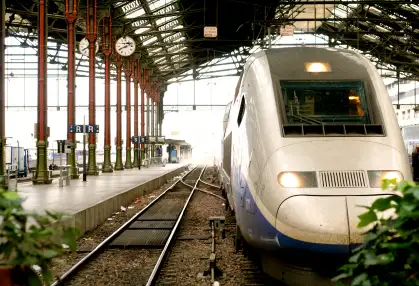
Last week’s opening of a new Metrorail branch to Miami International Airport highlights how many airports around the world you can reach through rail service. And although rail has many advantages over other ways to get to/from airports, some rail access systems are better than others.
Almost all airport access rail systems typically share three basic characteristics. Most airport stations are friendly to folks who need elevators or escalators. And most systems bypass some or all vehicular traffic. The main disadvantage is that fixed-route transit often doesn’t get you close enough to your local destination to avoid an extra taxi trip.
Airports around the world have up to four sorts of rail transit, with varying utility to travelers in general and specifically to seniors and others who might have trouble coping with stairs.
Heavy Rail Rapid Transit
All systems use traffic-free elevated or subway rights of way; fares are low and service is frequent. But typical downtown transit stations require you to walk (and schlep baggage) up or down one or more flights of stairs to get between track platform and street; downtown station stops are typically not located with nearby taxi stands; several systems require separate terminal-station people-movers or shuttle buses; only a few systems operate vehicles with adequate baggage space; and trains can be extremely crowded during rush hours.
Light Rail Rapid Transit
These systems share the advantages of low fares and frequent service. Many light rail systems have adopted low-floor vehicles, so getting on or off requires only one step. But many systems also involve at least some street running and can therefore get you caught in traffic.
Commuter Rail
Commuter rail systems typically terminate at a downtown station where you can easily catch a taxi to/from your final destination. Service is typically less frequent (often much less frequent) than rapid transit service, vehicles may entail stairs getting on or off, fares are usually higher than on rapid transit, and systems usually have only one or two downtown stops.
Intercity or Regional Rail
Many airports (mostly in Europe, but a few here) provide stops for intercity as well as commuter rail.
Miami’s new extension is heavy-rail rapid transit. The airport terminal is at a slightly remote car rental-parking complex accessed by a people-mover. Although it has some downtown stops, you’re most likely to transfer to the central-city people mover to get to your hotel. And there’s no rail connection to Miami Beach.
What North American Cities Offer
Heavy rail rapid transit direct from terminal to city center: Atlanta, Chicago/O’Hare, Chicago/Midway, Cleveland, Philadelphia, San Francisco, Vancouver, Washington/Reagan National.
Commuter and intercity heavy-rail transit requiring terminal-station transfer: Ft. Lauderdale (bus), Oakland (bus; building people-mover), Miami (bus), New York/JFK and Newark, (people-mover), Boston (bus), West Palm Beach (Bus).
Commuter rail direct from terminal: South Bend (but the train serves Chicago, not South Bend).
Commuter rail requiring terminal-station transfer: Burbank (bus), Chicago/O’Hare (people-mover plus bus), Dallas-Ft. Worth (bus), Montreal (bus), Newark (people mover), New York/JFK (people-mover), San Jose (bus).
Intercity rail (Amtrak) with shuttle bus to station: Baltimore, Burbank, Milwaukee.
Light rail direct from terminal: Baltimore, Minneapolis-St. Paul, Portland, St. Louis, Seattle-Tacoma.
Light rail with terminal-station shuttle bus: Los Angeles, Phoenix, San Jose.
Cities with some realistic expectation of new rail airport access by 2020 include Denver, Salt Lake City, Toronto, and Washington/Dulles, with a few others in the “pipe dream” phase.
Most big airports in Europe and Asia provide rail access. And most of those are served by commuter rail or heavy-rail transit; some by both. And some systems use vehicles especially configured with baggage racks (a big plus compared with typical North American systems).
Here, as elsewhere, rail access is one of several options to consider when you’re visiting a large city. Shuttle buses are often a better choice, however, and for parties of two or three, taxis are sometimes the best choice.
You Might Also Like:
- Could the Congressional Budget Crunch Shut Your Airport?
- Bus Travel Making a Big Comeback
- High Speed Trail in Michigan? Sort Of
Ed Perkins Seniors on the Go is copyright (c) 2012 Tribune Media Services, Inc.
We hand-pick everything we recommend and select items through testing and reviews. Some products are sent to us free of charge with no incentive to offer a favorable review. We offer our unbiased opinions and do not accept compensation to review products. All items are in stock and prices are accurate at the time of publication. If you buy something through our links, we may earn a commission.
Related
Top Fares From Columbus, OH
Today's Top Travel Deals
Brought to you by ShermansTravel
Shop and Save with Country Inns...
Patricia Magaña
 Hotel & Lodging Deals
Hotel & Lodging Deals
$229 -- Chicago: Discounted Rates and...
Francesca Miele
 Hotel & Lodging Deals
$229+
Hotel & Lodging Deals
$229+
$188 -- Honolulu: Save on Oceanview...
Abigail Lamay
 Hotel & Lodging Deals
$188+
Hotel & Lodging Deals
$188+



